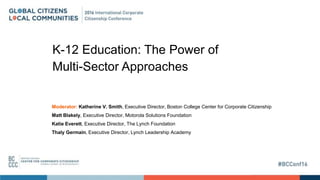
K-12 Education: Power of Multi-Sector Approaches
- 1. K-12 Education: The Power of Multi-Sector Approaches Moderator: Katherine V. Smith, Executive Director, Boston College Center for Corporate Citizenship Matt Blakely, Executive Director, Motorola Solutions Foundation Katie Everett, Executive Director, The Lynch Foundation Thaly Germain, Executive Director, Lynch Leadership Academy
- 2. © Community Involvement 20152 K-12 education: a top social issue 0% 10% 20% 30% 40% 50% 60% Communicable diseases Water Technology access Gender equality Small business and entrepreneurship Diversity and inclusion Work readiness Financial literacy Noncommunicable diseases Low-income housing Arts and culture Disaster relief Higher education Environmental sustainability Hunger and food security Community economic development STEM training and education Health and wellness Youth programs K-12 education CI_2015_Figure 9 Ranked No. 1 Ranked No. 2 Ranked No. 3 Ranked No. 4 Ranked No. 5 As was the case in previous studies, engagement with children and youth is a major priority for the majority of companies. Nearly 55% of companies include K-12 education among the issues they prioritize for attention and investment— a trend that has remained stable since the survey was first conducted in 1995. Top social issues addressed through community involvement efforts
- 3. © Community Involvement 20153 Measurement of corporate giving programs 0% 10% 20% 30% 40% 50% 60% 70% 80% Social impact Outcomes Outputs Inputs CI_2015_Figure 34 Eighty percent of companies use at least one level of measurement for their corporate giving programs. Nearly 80% are measuring inputs and outputs, yet only 13% measure social impact. Measurement of corporate giving programs
- 4. $42M in grants to over 100 organizations for STEM education since 2007 NGO and Strategic Volunteerism Pros: schools and program handled by NGO Cons: Same as above NGO and Intense Volunteerism Pros: deeper involvement Cons: Success depends on all parties NGO, Intense Volunteerism, and District Pros: bespoke approach Cons: replication a heavier lift
- 5. Best Practices for Multi-Sector Collaboration 1.Be very clear with expectations and timeline 2.Involve highest authorities possible 3.Focus on shared goals 4.Leverage any potential partners 5.Communicate constantly 6.Reward partners and volunteers 7.Be Flexible and Patient
- 6. How did it all begin? “One idea became a movement.”
- 7. Our Results Student Data: Massachusetts School Report Card; Overall school-level results of % students rated above proficient 15.3 6.7 English Language Arts Mathematics 2013 2014 outperform outperform outperformoutperform 95% of Academy schools demonstrated significant academic growth 96% retention rate in school leadership roles 27% of District principals are program alumni In 2014-2015, 30% of district principal hires were program alumni
- 8. Why Invest in Leadership? 1 25 330 School leaders account for 25% of a school’s impact on student learning. 24 out of 25 teachers say the principal is the #1 determinant in whether they stay or leave a school. A Multiplier Affect 1 School Leader 24 Teachers 600 Students Investments to draw retention would save a district 330K per year.
Editor's Notes
- Measurement level definitions Inputs resources needed to support a program (e.g., time spent, budget, materials, and marketing) Outputs units of goods or services that benefit a particular target audience (e.g., # of meals delivered and hours spent mentoring youth after school) Outcomes results, effects on target audience (e.g., awareness of senior mobility issues, reduced traffic in food pantries in community, lower school absence rate, and increased employee engagement) Social impact long term-effects on overall target audience (e.g., improved child health, better school performance, and decrease in youth involved in gang-related activity)
- Boston was the urban district where we began, and we have expanded now to communities in MA that serve similar low income students. I’d like to share with you today a little about our results to date, in impacting the principal pipeline and student outcomes in these communities - as evidence for our model - as we look to expand beyond MA this upcoming year. This is an effort that was kick-started 5 years ago by the Lynch Foundation, and is now operating with foundation funding, as well as district and corporate foundation support as we expand to other communities across MA. We are excited to use this discussion today to point to transformation of leadership made possible through these 3 sets of funding, along with innovation in the way we approach leadership training. When we began: While Boston leads the nation in student achievement scores on standardized state assessments, the achievement gap in Boston-area schools persists. In fact, Black and Latino students consistently lag behind their White and Asian counterparts in terms of graduation rates, college enrollment and overall proficiency on standardized assessments. Additionally, the college graduation rate for Boston Public School (BPS) students remains in the teens (19%). Black BPS students graduate college at an even lower than average rate of 13% and Latino students at a rate of 10% (2012). Given what we know about the impact of the principal on students, our vision is to improve student academic outcomes by building the leadership capacity of school leaders in high needs communities across Catholic, charter and district schools.
